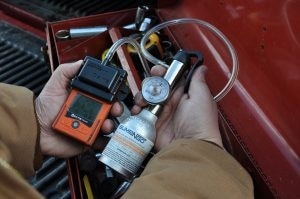Why is the Dangerfield Effect Important in Gas Detection?
With the use of four-gas monitors in the oil and gas field seeing a sharp increase over the last several years, the fact is clear that the dangers of this industry are not only related to hydrogen sulfide (H2S) in real life. For first-time users of this technology, who are quite numerous at present, the monitor is being used without due care – the so-called ‘Dangerfield Effect’, after the comedian Rodney Dangerfield who used to say he got no respect.
However, the consequences of negligent use can be serious, for both the individual and the oil company itself. This article explores some of the reasons for this phenomenon and the methods of preventing or correcting it.

Dangerfield performing in 1972.
Explanation of the Dangerfield Effect
When one uses an electronic device, it is necessary to observe the relationship between the user and the instrument. For instance, cell phones as well as gas detectors are commonly used by oilfield workers throughout the week. The cell phone is extremely valuable, since it allows one to stay in touch with developments on the field, to get any kind of required information at any location, and to connect with one’s family using FaceTime even while traveling.
These outputs come with some simple required inputs – charging the phone, paying for the data to be transmitted, and taking care of the phone. If a worker does not need these outputs or considers them to be useless, such as person will have a phone with none of these features, at the lowest possible price, and will use it seldom, if ever.
But for one who loves these facilities, a good phone is an important and continuing investment which constantly receives required inputs. In other words, such a user has a healthy relationship with the phone, partly because the ratio between the inputs and outputs is heavily skewed in favor of the latter.
First-time Users and Four-gas Monitors

Solutions like the Bump-N-Go gas cylinder make it easier for mobile works to perform daily bump tests before using the gas detector.
In this type of situation, the four-gas monitor needs some inputs:
- Bump testing
- Charging
- Calibration
However, the monitor yields some outputs, which are often not valued by the user, or viewed in a negative light. The alarm outputs are considered to be useless, or false, or simply a cause of downtime, as well as lowering productivity, leading to financial losses and work stoppage. Since these consequences are quite important, and there are many alarms compared to the few that were provided with the previous single gas monitor for H2S, the users end up depreciating the value of the outputs.
The inputs now are seen to be excessive compared to the outputs, which means the latter are now thought of as unimportant. The result is that the inputs are ignored. They may be performed inadequately, or in a delayed manner, or not at all. The monitors may not be used at all. This leads to the conclusion that these little lifesaving devices have now reached the point of being mere annoyances, and the users only want the monitors to be completely unreactive, not alarming at all.
They forget why these instruments are vital and find it hard to remember to perform the inconvenient or difficult but equally important inputs needed to keep them functioning correctly. They forget all about it, in short. They don’t remember that there is a very good reason that bump testing is recommended, as given in the fine print for every single device of this type. This should not be forgotten or glossed over during sales.
How Can This Situation be Corrected?
In many cases, an accident which causes fatalities or casualties is necessary to raise awareness of the importance of wearing and maintaining the four-gas monitors and bring users to pay them proper respect. But it doesn’t have to happen this way at all.
Instead, firstly, proper training must be imparted, within or outside the plant, on these detectors, their sphere of use, the factors that limit their usefulness, and how to respond correctly if they activate an alarm. This should include first-hand stories, including events that have occurred in the company in question or in the industry at large. This is important in building personal rapport between the workers using the detectors and the content of the training.
The second step is to monitor the gas detection program paying attention to points such as the maintenance of the equipment, detector use rate and manner, and the range of exposure, all of which may be easily obtained from the data logs. If this level of surveillance is not provided by the supervisory level of staff, it is useless to demand that workers wear the detectors.
Finally, the data should be made use of to give feedback on worker use of the detectors, with rewards to boost correct actions in this field. Discussions should be held with the employees, about things such as how they feel about the monitors, how gas exposure can be eliminated so that the detectors need not be worn, or can be used for much shorter durations, and the proper way to maintain detectors in good working condition.
This is not a detailed report but a platform to begin a dialogue between the management and workforce as to the reason for gas detectors, and their scope of use as well as their limitations. The purpose of these devices is improved safety in working conditions, and not to be sources of false alarms. To achieve this purpose and avoid the ‘Dangerfield Effect’, it is important to educate the workers, be deliberate and mindful in their use, and be honest as to their usefulness.
Once the outputs are thought of as important, the inputs will be provided as a matter of course. Gas detectors may be distinctly clunky and unfashionable, but even then, their role is to possibly save the worker’s life one day. For this one reason, they must be treated properly to achieve the right output, and recommended action must invariably be seen to occur following the output. There is no need to lose a worker before this truth is learned.

This information has been sourced, reviewed and adapted from materials provided by Industrial Scientific.
For more information on this source, please visit Industrial Scientific.